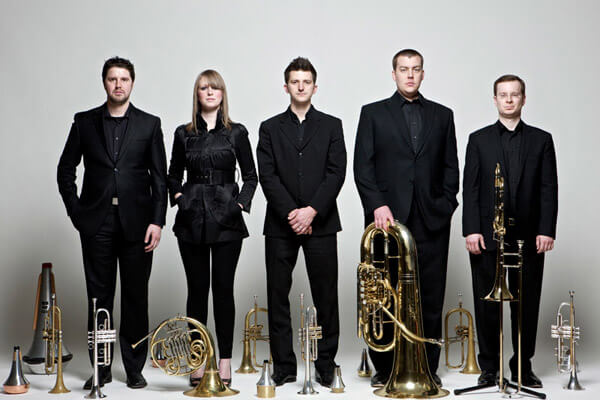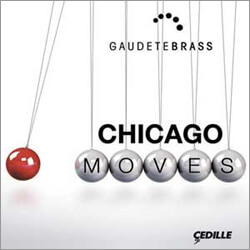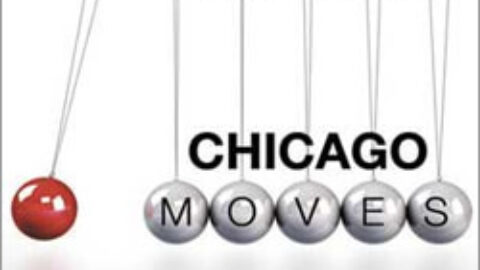 The Chicago based quintet Gaudete Brass presents here a celebration of new, American music for brass with seven new works commissioned or premiered by the ensemble. One of the greater goals of the group is to continue pushing new literature for the brass quintet, which, relatively speaking, is still in its adolescent stage as a modern chamber ensemble. This is especially true when compared to the seemingly endless oceans of work for small string or vocal ensembles, whose long and celebrated tradition of repertoire can be attributed very much to their having a long and celebrated tradition. The album Chicago Moves does well to promote Gaudete’s vision and to ensure that new music is being created for the brass quintet, as it includes six commissions by the ensemble completed since 2008.
The Chicago based quintet Gaudete Brass presents here a celebration of new, American music for brass with seven new works commissioned or premiered by the ensemble. One of the greater goals of the group is to continue pushing new literature for the brass quintet, which, relatively speaking, is still in its adolescent stage as a modern chamber ensemble. This is especially true when compared to the seemingly endless oceans of work for small string or vocal ensembles, whose long and celebrated tradition of repertoire can be attributed very much to their having a long and celebrated tradition. The album Chicago Moves does well to promote Gaudete’s vision and to ensure that new music is being created for the brass quintet, as it includes six commissions by the ensemble completed since 2008.

The group’s first (ever) commission and the album’s opening track is the jubilant Gaudete by James Woodward, a piece that very quickly places the album within the modern American style of concert music. Sweeping, Copland-esque solo lines and modal harmonies happily introducing you to the eponymous quintet. This continues with the 3-movement Sonata For Brass Quintet by John Cheetham, whose narrative musical style could stand alongside another American great in Leonard Bernstein. This is beautifully captured in the Andante movement, whose emotion and thematic development is rivaled only by the famous Canadian Brass recording of Bernstein’s Make My Garden Grow.
Moving away from what can be described with a wink as a more “traditional” brass quintet narrative style are A Great Commercial City by Brian Baxter and Chicago Moves, the title piece of the album by David Sampson. While both pieces have a programmatic element specifically about the city of Chicago, the piece by Baxter feels more modern and serious with prickly harmonies and a pacing more similar to the tense rise and falls in a film score. Sampson’s piece—the largest on the album in 4-movements—“showcases an aspect of life in Chicago, represented by a place or landmark,” and contains not necessarily a narrative, but rather vignettes of people and places. With its infusion of jazz and classical style, the piece as a whole feels extremely human. This is no more apparent than in “The Spaghetti Bowl,” an aptly named movement portraying the deeply human experience of navigating traffic and the weird personalities of others. Wildly different in mood and color, these two pieces contain some of the album’s better emotional moments.
Delving into the more technically difficult and abstract side of American music for brass are three tremendously welcome pieces of more “serious” concert music, and it is here that we can hear the players really flex their muscles. Stacy Garrop’s piece Helios is an extremely powerful piece in its beginning, with torrent rhythms and violent harmonies giving way to expressive, contemplative lines to its end. Within Brass, a simply titled, 3-movement composition by Rob Deemer, we are introduced to the more extended sonic possibilities of a brass quintet with the addition of mutes and modern techniques. In fact, the entire piece is a celebration of this, as the three movement are titled “Bell,” “Mute,” and “Slide,” with each section capturing these familiar brass characteristics in its own movement. Despite the simple titles, the music within these movements is extremely complex and occasionally loose, showing a great understanding of how to utilize such a small ensemble, and allowing the ensemble to show off both its technical and soloistic prowesses.
 The album’s finale, Copperwave, was originally written by Joan Tower in a very similar yet slightly different instrumentation. It is premiered here as a traditional brass quintet, though was originally written with a bass trombone. Within this piece we’re pulled through a variety of different stylistic attributes that have popped up in Deemer’s piece with extended techniques: long, brash solo lines; tense, prickly harmonic movement; and the rhythmic ebbs and flows only possible with a small chamber group. Tower’s piece makes great use of the power of the ensemble as well as the individual, and melds them with jarring effect. Far and away the premier “serious” piece on this album (partially aided by the near celebrity status of the composer within American Music circles), its placement at the end of the album seems to highlight the desire by the ensemble to show the evolution all of the compositional techniques preceding it and to showcase a wider survey of the American style.
The album’s finale, Copperwave, was originally written by Joan Tower in a very similar yet slightly different instrumentation. It is premiered here as a traditional brass quintet, though was originally written with a bass trombone. Within this piece we’re pulled through a variety of different stylistic attributes that have popped up in Deemer’s piece with extended techniques: long, brash solo lines; tense, prickly harmonic movement; and the rhythmic ebbs and flows only possible with a small chamber group. Tower’s piece makes great use of the power of the ensemble as well as the individual, and melds them with jarring effect. Far and away the premier “serious” piece on this album (partially aided by the near celebrity status of the composer within American Music circles), its placement at the end of the album seems to highlight the desire by the ensemble to show the evolution all of the compositional techniques preceding it and to showcase a wider survey of the American style.
The album is a tremendous addition to the discography and literature for brass ensembles. Gaudete Brass gives here an exceptionally clean performance of wildly difficult and stylistically different musical compositions, and it’s hard to stress enough just how important that is for new commissions. Much can be made of the musical content within these new pieces of music specifically because of the strength of this ensemble’s performances. Between sections of deeply emotive, soloistic playing, we are also treated to completely off the cuff technical wonders in virtuoso ensemble playing. The American brass tradition is thriving in this recording on all fronts, and that fact in itself is truly worth celebrating.
Gaudete Brass, Chicago Moves (Cedille Records, 2012) | Buy it on Amazon US | Amazon UK | Amazon CA
























